Driving Supply Chain Transformation with IoT and AI Integration: A Dual Approach Using Bibliometric Analysis and Topic Modeling
Abstract
:1. Introduction
2. Research Method
2.1. Data Collection
2.2. Bibliometric Analysis
2.3. Topic Modeling
3. Results
3.1. Bibliometric Analysis Using Biblioshiny and VOSviewer
3.1.1. Annual Production of Publications
3.1.2. Most Globally and Locally Cited Documents
3.1.3. Most Relevant Keywords
3.1.4. Trend Topic Analysis
3.1.5. Co-Occurrence Network of Keywords
3.1.6. Co-Citation Network of Cited References
3.2. Topic Modeling and Cluster Identification
3.3. Application of AI Algorithms in IoT-Based Supply Chain Management
4. Discussion
4.1. AI and IoT in Supply Chains
4.2. The Role of AI and IoT in the Digital Transformation of Supply Chains in Industry 4.0
5. Conclusions, Limitations, and Future Scope
Author Contributions
Funding
Data Availability Statement
Conflicts of Interest
Abbreviations
| AI | Artificial Intelligence |
| IoT | Internet of Things |
| SC | Supply Chain |
| SCM | Supply Chain Management |
| RFID | Radio Frequency Identification |
| ML | Machine Learning |
| IDS | Intrusion Detection System |
| NMF | Non-Negative Matrix Factorization |
| LSA | Latent Semantic Analysis |
| LDA | Latent Dirichlet Allocation |
| PLSA | Probabilistic Latent Semantic Analysis |
| IoTRMS | IoT- and AI-Based Risk Monitoring System |
| PUF | Physically Unclonable Function |
| CE | Circular Economy |
| FL | Federated Learning |
| PP-SPA | Privacy-Preserved Smartphone-Based Personal Assistant |
| LSTM | Long Short-Term Memory |
| GRU | Gated Recurrent Unit |
| GA | Genetic Algorithm |
| GAN | Generative Adversarial Network |
| FEDGS | Federated Group Synchronization Framework |
| t-SNE | t-Distributed Stochastic Neighbor Embedding |
| SCADA | Supervisory Control and Data Acquisition |
| GIS | Geographic Information System |
| C-TPAT | Customs-Trade Partnership Against Terrorism |
| FSMA | Food Safety Modernization Act |
| GDPR | General Data Protection Regulation |
| KNN | K-Nearest Neighbors |
| SVM | Support Vector Machine |
| ANN | Artificial Neural Network |
| CNN | Convolutional Neural Network |
| RL | Reinforcement Learning |
| PCA | Principal Component Analysis |
References
- Sharma, A.K.; Srivastava, M.K.; Sharma, R. Exposition of Techno-Functional Components of Intelligent Food Supply Chain: A Review and Future Research Agenda. J. Bus. Ind. Mark. 2024, 39, 1928–1949. [Google Scholar] [CrossRef]
- Taj, S.; Imran, A.S.; Kastrati, Z.; Daudpota, S.M.; Memon, R.A.; Ahmed, J. IoT-Based Supply Chain Management: A Systematic Literature Review. Int. Things 2023, 24, 100982. [Google Scholar] [CrossRef]
- Rejeb, A.; Keogh, J.G.; Treiblmaier, H. Leveraging the Internet of Things and Blockchain Technology in Supply Chain Management. Future Int. 2019, 11, 161. [Google Scholar] [CrossRef]
- Mridha, M.T. IoT-Based Warehouse Management System: Enhancing Warehouse Efficiency and Worker Health Monitoring System; BRAC University: Dhaka, Bangladesh, 2022. [Google Scholar] [CrossRef]
- Sallam, K.M.; Wagdy Mohamed, A.; Mohamed, M. Internet of Things (IoT) in Supply Chain Management: 1 Challenges, Opportunities, and Best Practices. Sustain. Mach. Intell. J. 2023, 2, 1–32. [Google Scholar] [CrossRef]
- Du, J. The Impact and Challenges of the Internet of Things (IoT) on Supply Chain Management. In Proceedings of the 2022 2nd International Conference on Enterprise Management and Economic Development, Dalian, China, 27–29 May 2022. [Google Scholar] [CrossRef]
- Shoomal, A.; Jahanbakht, M.; Componation, P.J.; Ozay, D. Enhancing Supply Chain Resilience and Efficiency through Internet of Things Integration: Challenges and Opportunities. Int. Things 2024, 27, 101324. [Google Scholar] [CrossRef]
- Shahzadi, G.; Jia, F.; Chen, L.; John, A. AI Adoption in Supply Chain Management: A Systematic Literature Review. J. Manuf. Technol. Manag. 2024, 35, 1125–1150. [Google Scholar] [CrossRef]
- Kayikci, S.; Khoshgoftaar, T.M. Blockchain Meets Machine Learning: A Survey. J. Big Data 2024, 11, 9. [Google Scholar] [CrossRef]
- Liao, H.-J.; Richard Lin, C.-H.; Lin, Y.-C.; Tung, K.-Y. Intrusion Detection System: A Comprehensive Review. J. Netw. Comput. Appl. 2013, 36, 16–24. [Google Scholar] [CrossRef]
- Jacob, N.M.; Wanjala, M.Y. A Review of Intrusion Detection Systems. Int. J. Comput. Sci. Inf. Technol. Res. 2017, 17, 11–14. [Google Scholar]
- Eid, A.M.; Soudan, B.; Nassif, A.B.; Injadat, M. Comparative Study of ML Models for IIoT Intrusion Detection: Impact of Data Preprocessing and Balancing. Neural Comput. Appl. 2024, 36, 6955–6972. [Google Scholar] [CrossRef]
- Alheadary, W.G. The Impacts of the Internet of Things and Artificial Intelligence on Logistics in Supply Chain Management. Int. J. Adv. Appl. Sci. 2024, 11, 161–168. [Google Scholar] [CrossRef]
- Khan, A.; Goodell, J.W.; Hassan, M.K.; Paltrinieri, A. A Bibliometric Review of Finance Bibliometric Papers. Financ. Res. Lett. 2022, 47, 102520. [Google Scholar] [CrossRef]
- Zaman, J. IoT and AI in Supply Chain; Elsevier: Amsterdam, The Netherlands, 2024. [Google Scholar] [CrossRef]
- Phoong, S.W.; Phoong, S.Y.; Khek, S.L. Systematic Literature Review With Bibliometric Analysis on Markov Switching Model: Methods and Applications. Sage Open 2022, 12, 21582440221093062. [Google Scholar] [CrossRef]
- Gauthier, É. Bibliometric Analysis of Scientific and Technological Research: A User’s Guide To The Methodology. In Science and Technology Redesign Project Statistics; Observatoire des Sciences et des Technologies (CIRST): Ottawa, ON, Canada, 1998. [Google Scholar]
- McBurney, M.K.; Novak, P.L. What Is Bibliometrics and Why Should You Care? In Proceedings of the IEEE International Professional Communication Conference, Portland, OR, USA, 20 September 2002; pp. 108–114. [Google Scholar] [CrossRef]
- Wei, W.; Jiang, Z. A Bibliometrix-Based Visualization Analysis of International Studies on Conversations of People with Aphasia: Present and Prospects. Heliyon 2023, 9, e16839. [Google Scholar] [CrossRef] [PubMed]
- Aria, M.; Cuccurullo, C. Bibliometrix: An R-Tool for Comprehensive Science Mapping Analysis. J. Inf. 2017, 11, 959–975. [Google Scholar] [CrossRef]
- Lam, W.S.; Lam, W.H.; Lee, P.F. A Bibliometric Analysis of Digital Twin in the Supply Chain. Mathematics 2023, 11, 3350. [Google Scholar] [CrossRef]
- Bukar, U.A.; Sayeed, M.S.; Razak, S.F.A.; Yogarayan, S.; Amodu, O.A.; Mahmood, R.A.R. A Method for Analyzing Text Using VOSviewer. MethodsX 2023, 11, 102339. [Google Scholar] [CrossRef]
- Sevukan, R.; Sankar, S. Application of Author Bibliographic Coupling Analysis and Author Keywords Ranking in Identifying Research Fronts of Indian Neurosciences Research. Libr. Philos. Pract. 2019, 2439. Available online: https://digitalcommons.unl.edu/libphilprac/2439/ (accessed on 6 February 2025).
- Odumuyiwa, V.; Osuntoki, S.B.; Sennaike, O. Understanding Document Thematic Structure: A Systematic Review of Topic Modeling Algorithms. J. Inf. Organ. Sci. 2022, 46, 305–322. [Google Scholar] [CrossRef]
- Ozay, D.; Jahanbakht, M.; Componation, P.; Shoomal, A. State of the Art and Themes of the Research on Artificial Intelligence (AI) Integrated Customer Relationship Management (CRM): Bibliometric Analysis and Topic Modelling. In Proceedings of the 2023 IEEE International Conference on Technology Management, Operations and Decisions (ICTMOD), Rabat, Morocco, 22–24 November 2023. [Google Scholar] [CrossRef]
- Kherwa, P.; Bansal, P. Topic Modeling: A Comprehensive Review. ICST Trans. Scalable Inf. Syst. 2019, 7, e2. [Google Scholar] [CrossRef]
- Blei, D.M.; Ng, A.Y.; Jordan, M. Latent Dirichlet Allocation. J. Mach. Learn. Res. 2001, 3, 993–1022. [Google Scholar]
- Altaweel, M.; Bone, C.; Abrams, J. Documents as Data: A Content Analysis and Topic Modeling Approach for Analyzing Responses to Ecological Disturbances. Ecol. Inform. 2019, 51, 82–95. [Google Scholar] [CrossRef]
- Egger, R.; Yu, J. Identifying Hidden Semantic Structures in Instagram Data: A Topic Modelling Comparison. Tour. Rev. 2022, 77, 1234–1246. [Google Scholar] [CrossRef]
- Liu, Y.; Ma, X.; Shu, L.; Hancke, G.P.; Abu-Mahfouz, A.M. From Industry 4.0 to Agriculture 4.0: Current Status, Enabling Technologies, and Research Challenges. IEEE Trans. Ind. Inf. 2021, 17, 4322–4334. [Google Scholar] [CrossRef]
- Misra, N.N.; Dixit, Y.; Al-Mallahi, A.; Bhullar, M.S.; Upadhyay, R.; Martynenko, A. IoT, Big Data, and Artificial Intelligence in Agriculture and Food Industry. IEEE Int. Things J. 2022, 9, 6305–6324. [Google Scholar] [CrossRef]
- Saurabh, S.; Dey, K. Blockchain Technology Adoption, Architecture, and Sustainable Agri-Food Supply Chains. J. Clean. Prod. 2021, 284, 124731. [Google Scholar] [CrossRef]
- Ahad, M.A.; Paiva, S.; Tripathi, G.; Feroz, N. Enabling Technologies and Sustainable Smart Cities. Sustain. Cities Soc. 2020, 61, 102301. [Google Scholar] [CrossRef]
- Moosavi, J.; Fathollahi-Fard, A.M.; Dulebenets, M.A. Supply Chain Disruption during the COVID-19 Pandemic: Recognizing Potential Disruption Management Strategies. Int. J. Disaster Risk Reduct. 2022, 75, 102983. [Google Scholar] [CrossRef]
- Kusiak, A. Smart Manufacturing. Int. J. Prod. Res. 2018, 56, 508–517. [Google Scholar] [CrossRef]
- Wang, S.; Tuor, T.; Salonidis, T.; Leung, K.K.; Makaya, C.; He, T.; Chan, K. When Edge Meets Learning: Adaptive Control for Resource-Constrained Distributed Machine Learning. In Proceedings of the IEEE INFOCOM 2018—IEEE Conference on Computer Communications, Honolulu, HI, USA, 16–19 April 2018; pp. 63–71. [Google Scholar] [CrossRef]
- Tang, C.S.; Veelenturf, L.P. The Strategic Role of Logistics in the Industry 4.0 Era. Transp. Res. Part E Logist. Transp. Rev. 2019, 129, 1–11. [Google Scholar] [CrossRef]
- Tsang, Y.P.; Choy, K.L.; Wu, C.-H.; Ho, G.T.; Lam, H.; Koo, P.S. An Internet of Things (IoT)-Based Risk Monitoring System for Managing Cold Supply Chain Risks. Ind. Manag. Data Syst. 2018, 118, 1432–1462. [Google Scholar] [CrossRef]
- Hopkins, J.; Hawking, P. Big Data Analytics and IoT in Logistics: A Case Study. Int. J. Logist. Manag. 2018, 29, 575–591. [Google Scholar] [CrossRef]
- Hassija, V.; Chamola, V.; Gupta, V.; Jain, S.; Guizani, N. A Survey on Supply Chain Security: Application Areas, Security Threats, and Solution Architectures. IEEE Int. Things J. 2021, 8, 6222–6246. [Google Scholar] [CrossRef]
- Bhargava, A.; Bhargava, D.; Kumar, P.N.; Sajja, G.S.; Ray, S. Industrial IoT and AI Implementation in Vehicular Logistics and Supply Chain Management for Vehicle Mediated Transportation Systems. Int. J. Syst. Assur. Eng. Manag. 2022, 13, 673–680. [Google Scholar] [CrossRef]
- Alfian, G.; Syafrudin, M.; Farooq, U.; Ma’arif, M.R.; Syaekhoni, M.A.; Fitriyani, N.L.; Lee, J.; Rhee, J. Improving Efficiency of RFID-Based Traceability System for Perishable Food by Utilizing IoT Sensors and Machine Learning Model. Food Control 2020, 110, 107016. [Google Scholar] [CrossRef]
- Rajimol, A.; George, J.; Joseph, J.; Jose, J.; Kuriakose, S.M.; Amolet, B. Charting New Frontiers: Assessing Information Technology’s Role In The Evolution of Image Enhancement-A Bibliometric Approach. J. Theor. Appl. Inf. Technol. 2024, 102, 2269–2286. [Google Scholar]
- Cai, Y.; Qi, C. Blockchain Technology Applications in Retail and Insurance Sectors: Cases from Suning and PingAn. In Proceedings of the 2021 International Conference on Artificial Intelligence and Blockchain Technology (AIBT), Beijing, China, 4–6 December 2021; pp. 80–84. [Google Scholar] [CrossRef]
- Alammary, A.; Alhazmi, S.; Almasri, M.; Gillani, S. Blockchain-Based Applications in Education: A Systematic Review. Appl. Sci. 2019, 9, 2400. [Google Scholar] [CrossRef]
- Hexmoor, H.; Maghsoudlou, E. IoT with Blockchain: A New Infrastructure Proposal. In Proceedings of the 39th International Conference on Computers and Their Applications, New Orleans, LA, USA, 18–19 March 2024. [Google Scholar] [CrossRef]
- Yaqoub, M.; Gao, Z.; Ye, X.; Al-Kassimi, K.; Chen, Z.; Haizhou, W. Three Decades of Glocalization Research: A Bibliometric Analysis. Cogent Soc. Sci. 2023, 9, 2245239. [Google Scholar] [CrossRef]
- Wang, M.; Wang, Q.-Y.; Zhang, Y.-H.; Zhang, Z.-X.; Feng, Y.-N.; Cao, Y.-F. Preserving Differential Privacy in Neural Networks for Foreign Object Detection with Heterogeneity-Based Noising among Distributed Devices. J. Supercomput. 2024, 80, 21447–21474. [Google Scholar] [CrossRef]
- Zhao, C.; Wen, Y.; Shuailou, L.; Liu, F.; Meng, D. FederatedReverse: A Detection and Defense Method Against Backdoor Attacks in Federated Learning. In Proceedings of the 2021 ACM Workshop on Information Hiding and Multimedia Security, New York, NY, USA, 22–25 June 2021. [Google Scholar] [CrossRef]
- Qin, Z.; Li, G.Y.; Ye, H. Federated Learning and Wireless Communications. IEEE Wirel. Commun. 2021, 28, 134–140. [Google Scholar] [CrossRef]
- Alferaidi, A.; Yadav, K.; Alharbi, Y.; Viriyasitavat, W.; Kautish, S.; Dhiman, G. Federated Learning Algorithms to Optimize the Client and Cost Selections. Math. Probl. Eng. 2022, 2022, 8514562. [Google Scholar] [CrossRef]
- Priya, J.C.; Nanthakumar, G.; Choudhury, T.; Karthika, K. 6G-DeFLI: Enhanced Quality-of-Services Using Distributed Hash Table and Blockchain-Enabled Federated Learning Approach in 6G IoT Networks. Wirel. Netw. 2024, 31, 361–375. [Google Scholar] [CrossRef]
- Lim, J.B.; Jeong, J. Factory Simulation of Optimization Techniques Based on Deep Reinforcement Learning for Storage Devices. Appl. Sci. 2023, 13, 9690. [Google Scholar] [CrossRef]
- Serôdio, C.; Mestre, P.; Cabral, J.; Gomes, M.; Branco, F. Software and Architecture Orchestration for Process Control in Industry 4.0 Enabled by Cyber-Physical Systems Technologies. Appl. Sci. 2024, 14, 2160. [Google Scholar] [CrossRef]
- Shaikh, T.A.; Rasool, T.; Verma, P. Machine Intelligence and Medical Cyber-Physical System Architectures for Smart Healthcare: Taxonomy, Challenges, Opportunities, and Possible Solutions. Artif. Intell. Med. 2023, 146, 102692. [Google Scholar] [CrossRef] [PubMed]
- Kirtania, D.K. Network Visualization of ChatGPT Research: A Study Based on Term and Keyword Co-Occurrence Network Analysis. arXiv 2023, arXiv:2304.01948. [Google Scholar] [CrossRef]
- Bornmann, L.; Haunschild, R.; Hug, S.E. Visualizing the Context of Citations Referencing Papers Published by Eugene Garfield: A New Type of Keyword Co-Occurrence Analysis. Scientometrics 2018, 114, 427–437. [Google Scholar] [CrossRef]
- Rymarczyk, J. Technologies, Opportunities and Challenges of the Industrial Revolution 4.0: Theoretical Considerations. Entrep. Bus. Econ. Rev. 2020, 8, 185–198. [Google Scholar] [CrossRef]
- Akundi, A.; Euresti, D.; Luna, S.; Ankobiah, W.; Lopes, A.; Edinbarough, I. State of Industry 5.0—Analysis and Identification of Current Research Trends. Appl. Syst. Innov. 2022, 5, 27. [Google Scholar] [CrossRef]
- Arden, N.S.; Fisher, A.C.; Tyner, K.; Yu, L.X.; Lee, S.L.; Kopcha, M. Industry 4.0 for Pharmaceutical Manufacturing: Preparing for the Smart Factories of the Future. Int. J. Pharm. 2021, 602, 120554. [Google Scholar] [CrossRef]
- Asokan, D.; Huq, F.; Smith, C.; Stevenson, M. Socially Responsible Operations in the Industry 4.0 Era: Post-COVID-19 Technology Adoption and Perspectives on Future Research. Int. J. Oper. Prod. Manag. 2022, 42, 185–217. [Google Scholar] [CrossRef]
- Nandi, S.; Hervani, A.A.; Helms, M.M.; Sarkis, J. Conceptualising Circular Economy Performance with Non-Traditional Valuation Methods: Lessons for a Post-Pandemic Recovery. Int. J. Logist. Res. Appl. 2023, 26, 662–682. [Google Scholar] [CrossRef]
- Khameneh, R.T.; Elyasi, M.; Özener, O.Ö.; Ekici, A. A Non-Clustered Approach to Platelet Collection Routing Problem. Comput. Oper. Res. 2023, 160, 106366. [Google Scholar] [CrossRef]
- Gupta, D.; Bhatt, S.; Gupta, M.; Tosun, A.S. Future Smart Connected Communities to Fight COVID-19 Outbreak. Int. Things 2021, 13, 100342. [Google Scholar] [CrossRef]
- Elayan, H.; Aloqaily, M.; Guizani, M. Sustainability of Healthcare Data Analysis IoT-Based Systems Using Deep Federated Learning. IEEE Int. Things J. 2022, 9, 7338–7346. [Google Scholar] [CrossRef]
- Javed, A.R.; Sarwar, M.U.; Rehman, S.U.; Khan, H.U.; Al-Otaibi, Y.D.; Alnumay, W.S. PP-SPA: Privacy Preserved Smartphone-Based Personal Assistant to Improve Routine Life Functioning of Cognitive Impaired Individuals. Neural Process Lett. 2023, 55, 35–52. [Google Scholar] [CrossRef]
- Shumba, A.T.; Montanaro, T.; Sergi, I.; Fachechi, L.; De Vittorio, M.; Patrono, L. Leveraging IoT-Aware Technologies and AI Techniques for Real-Time Critical Healthcare Applications. Sensors 2022, 22, 7675. [Google Scholar] [CrossRef]
- Chang, V.; Doan, L.M.T.; Xu, Q.A.; Hall, K.; Wang, Y.A.; Kamal, M.M. Digitalization in Omnichannel Healthcare Supply Chain Businesses: The Role of Smart Wearable Devices. J. Bus. Res. 2023, 156, 113369. [Google Scholar] [CrossRef]
- Khan, P.W.; Byun, Y.; Park, N. IoT-Blockchain Enabled Optimized Provenance System for Food Industry 4.0 Using Advanced Deep Learning. Sensors 2020, 20, 2990. [Google Scholar] [CrossRef]
- Kashyap, P.; Kumar, S.; Jaiswal, A.; Prasad, M.; Gandomi, A. Towards Precision Agriculture: IoT-Enabled Intelligent Irrigation Systems Using Deep Learning Neural Network. IEEE Sens. J. 2021, 21, 17479–17491. [Google Scholar] [CrossRef]
- Jararweh, Y.; Fatima, S.; Jarrah, M.; AlZu’bi, S. Smart and Sustainable Agriculture: Fundamentals, Enabling Technologies, and Future Directions. Comput. Electr. Eng. 2023, 110, 108799. [Google Scholar] [CrossRef]
- Cheng, W.; Ma, T.; Wang, X.; Wang, G. Anomaly Detection for Internet of Things Time Series Data Using Generative Adversarial Networks With Attention Mechanism in Smart Agriculture. Front. Plant Sci. 2022, 13, 890563. [Google Scholar] [CrossRef]
- Frikha, T.; Ktari, J.; Zalila, B.; Ghorbel, O.; Amor, N.B. Integrating Blockchain and Deep Learning for Intelligent Greenhouse Control and Traceability. Alex. Eng. J. 2023, 79, 259–273. [Google Scholar] [CrossRef]
- Preuveneers, D.; Ilie-Zudor, E. The Intelligent Industry of the Future: A Survey on Emerging Trends, Research Challenges and Opportunities in Industry 4.0. J. Ambient. Intell. Smart Environ. 2017, 9, 287–298. [Google Scholar] [CrossRef]
- Alcaraz, C.; Lopez, J. Digital Twin: A Comprehensive Survey of Security Threats. IEEE Commun. Surv. Tutor. 2022, 24, 1475–1503. [Google Scholar] [CrossRef]
- Teoh, Y.K.; Gill, S.S.; Parlikad, A.K. IoT and Fog-Computing-Based Predictive Maintenance Model for Effective Asset Management in Industry 4.0 Using Machine Learning. IEEE Int. Things J. 2023, 10, 2087–2094. [Google Scholar] [CrossRef]
- Li, Z.; He, Y.; Yu, H.; Kang, J.; Li, X.; Xu, Z.; Niyato, D. Data Heterogeneity-Robust Federated Learning via Group Client Selection in Industrial IoT. IEEE Int. Things J. 2022, 9, 17844–17857. [Google Scholar] [CrossRef]
- Zhan, X.; Wu, W.; Shen, L.; Liao, W.; Zhao, Z.; Xia, J. Industrial Internet of Things and Unsupervised Deep Learning Enabled Real-Time Occupational Safety Monitoring in Cold Storage Warehouse. Saf. Sci. 2022, 152, 105766. [Google Scholar] [CrossRef]
- Shi, W.; Cao, J.; Zhang, Q.; Li, Y.; Xu, L. Edge Computing: Vision and Challenges. IEEE Int. Things J. 2016, 3, 637–646. [Google Scholar] [CrossRef]
- Li, X.; Liu, H.; Wang, W.; Zheng, Y.; Lv, H.; Lv, Z. Big Data Analysis of the Internet of Things in the Digital Twins of Smart City Based on Deep Learning. Future Gener. Comput. Syst. 2022, 128, 167–177. [Google Scholar] [CrossRef]
- Vijai, P.; Sivakumar, P.B. Design of IoT Systems and Analytics in the Context of Smart City Initiatives in India. Procedia Comput. Sci. 2016, 92, 583–588. [Google Scholar] [CrossRef]
- Valerio, L.; Passarella, A.; Conti, M. A Communication Efficient Distributed Learning Framework for Smart Environments. Pervasive Mob. Comput. 2017, 41, 46–68. [Google Scholar] [CrossRef]
- Chen, X. The Development Trend and Practical Innovation of Smart Cities under the Integration of New Technologies. Front. Eng. Manag. 2019, 6, 485–502. [Google Scholar] [CrossRef]
- Su, Z.; Wang, Y.; Luan, T.; Zhang, N.; Li, F.; Chen, T.; Cao, H. Secure and Efficient Federated Learning for Smart Grid With Edge-Cloud Collaboration. IEEE Trans. Ind. Inform. 2021, 18, 1333–1344. [Google Scholar] [CrossRef]
- D’Amico, G.; Szopik-Depczyńska, K.; Dembińska, I.; Ioppolo, G. Smart and Sustainable Logistics of Port Cities: A Framework for Comprehending Enabling Factors, Domains and Goals. Sustain. Cities Soc. 2021, 69, 102801. [Google Scholar] [CrossRef]
- Mohanasundaram, J.; Reddy, C.; Padmanaban, S.; Milyani, A. Operational Planning Steps in Smart Electric Power Delivery System. Sci. Rep. 2021, 11, 17250. [Google Scholar] [CrossRef]
- Xia, X.; Xiao, Y.; Liang, W.; Cui, J. Detection Methods in Smart Meters for Electricity Thefts: A Survey. Proc. IEEE 2022, 110, 273–319. [Google Scholar] [CrossRef]
- Rabie, A.H.; Ali, S.H.; Ali, H.A.; Saleh, A.I. A Fog Based Load Forecasting Strategy for Smart Grids Using Big Electrical Data. Clust. Comput. 2019, 22, 241–270. [Google Scholar] [CrossRef]
- Xu, S.; Zhang, X.; Feng, L.; Yang, W. Disruption Risks in Supply Chain Management: A Literature Review Based on Bibliometric Analysis. Int. J. Prod. Res. 2020, 58, 3508–3526. [Google Scholar] [CrossRef]
- van Eck, N.J.; Waltman, L. Visualizing Bibliometric Networks. In Measuring Scholarly Impact; Springer International Publishing: Cham, Switzerland, 2014; pp. 285–320. [Google Scholar] [CrossRef]
- McMahan, H.B.; Eider, M.; Ramage, D.; Hampson, S.; Arcas, B.A.y. Communication-Efficient Learning of Deep Networks from Decentralized Data. In Proceedings of the 20th International Conference on Artificial Intelligence and Statistics (AISTATS) 2017, Ft. Lauderdale, FL, USA, 20–22 April 2017. [Google Scholar] [CrossRef]
- Kingma, D.P.; Ba, J. Adam: A Method for Stochastic Optimization. arXiv 2014, arXiv:1412.6980. [Google Scholar] [CrossRef]
- Lecun, Y.; Bottou, L.; Bengio, Y.; Haffner, P. Gradient-Based Learning Applied to Document Recognition. Proc. IEEE 1998, 86, 2278–2324. [Google Scholar] [CrossRef]
- LeCun, Y.; Bengio, Y.; Hinton, G. Deep Learning. Nature 2015, 521, 436–444. [Google Scholar] [CrossRef]
- Koroniotis, N.; Moustafa, N.; Sitnikova, E.; Turnbull, B. Towards the Development of Realistic Botnet Dataset in the Internet of Things for Network Forensic Analytics: Bot-IoT Dataset. Future Gener. Comput. Syst. 2019, 100, 779–796. [Google Scholar] [CrossRef]
- Qi, Q.; Tao, F. Digital Twin and Big Data Towards Smart Manufacturing and Industry 4.0: 360 Degree Comparison. IEEE Access 2018, 6, 3585–3593. [Google Scholar] [CrossRef]
- Atzori, L.; Iera, A.; Morabito, G. The Internet of Things: A Survey. Comput. Netw. 2010, 54, 2787–2805. [Google Scholar] [CrossRef]
- Gubbi, J.; Buyya, R.; Marusic, S.; Palaniswami, M. Internet of Things (IoT): A Vision, Architectural Elements, and Future Directions. Future Gener. Comput. Syst. 2013, 29, 1645–1660. [Google Scholar] [CrossRef]
- Al-Fuqaha, A.; Guizani, M.; Mohammadi, M.; Aledhari, M.; Ayyash, M. Internet of Things: A Survey on Enabling Technologies, Protocols and Applications. IEEE Commun. Surv. Tutor. 2015, 17, 2347–2376. [Google Scholar] [CrossRef]
- Xu, L.; He, W.; Li, S. Internet of Things in Industries: A Survey. IEEE Trans. Ind. Inf. 2014, 10, 2233–2243. [Google Scholar] [CrossRef]
- Ben-Daya, M.; Hassini, E.; Bahroun, Z. Internet of Things and Supply Chain Management: A Literature Review. Int. J. Prod. Res. 2017, 57, 4719–4742. [Google Scholar] [CrossRef]
- Zhao, J.; Feng, Q.P.; Wu, P.; Warner, J.L.; Denny, J.C.; Wei, W.Q. Using Topic Modeling via Non-Negative Matrix Factorization to Identify Relationships between Genetic Variants and Disease Phenotypes: A Case Study of Lipoprotein(a) (LPA). PLoS ONE 2019, 14, e0212112. [Google Scholar] [CrossRef]
- Van Der Maaten, L.; Hinton, G. Visualizing Data Using T-SNE. J. Mach. Learn. Res. 2008, 9, 2579–2605. [Google Scholar]
- Hinton, G.E.; Roweis, S.T. Stochastic Neighbor Embedding. In Proceedings of the 15th International Conference on Neural Information Processing Systems, Vancouver, BC, Canada, 9–12 December 2002. [Google Scholar]
- Islam, T. Yoga-Veganism: Correlation Mining of Twitter Health Data. In Proceedings of the 8th KDD Workshop on Issues of Sentiment Discovery and Opinion Mining, Anchorage, AK, USA, 4 August 2019. [Google Scholar]
- Sun, X.; Gao, L.; Liang, Y. Research on Big Data Acquisition and Application of Cold Chain Logistics Based on Artificial Intelligence and Energy Internet of Things. IOP Conf. Ser. Earth Environ. Sci. 2019, 252, 052052. [Google Scholar] [CrossRef]
- Li, L. Deep Learning Algorithm Aided E-Commerce Logistics Node Layout Optimization Based on Internet of Things Network. EAI Endorsed Trans. Scalable Inf. Syst. 2023, 10, e16. [Google Scholar] [CrossRef]
- Shi, N.; Zeping, L.; Zhou, L. The Construction Elements of Modern Logistics System. J. Phys. Conf. Ser. 2019, 1176, 42060. [Google Scholar] [CrossRef]
- Zhang, N.; Zheng, K. Research and Design of the Architecture of the Marine Logistics Information Platform Based on Big Data. J. Coast. Res. 2020, 106, 628–632. [Google Scholar] [CrossRef]
- Ilin, V.; Simić, D.; Saulic, N. Logistics Industry 4.0: Challenges and Opportunities. In Proceedings of the LOGIC: 4th Logistics International Conference, Belgrade, Serbia, 23–25 May 2019. [Google Scholar]
- Soltaninejad, M.; Aghazadeh, R.; Shaghaghi, S.; Zarei, M. Using Machine Learning Techniques to Forecast Mehram Company’s Sales: A Case Study. J. Bus. Manag. Stud. 2024, 6, 42–53. [Google Scholar] [CrossRef]
- Figueiredo, I.; Esteves, P.; Cabrita, P. Water Wise—A Digital Water Solution for Smart Cities and Water Management Entities. Procedia Comput. Sci. 2021, 181, 897–904. [Google Scholar] [CrossRef]
- Machado, M.R.; Júnior, T.R.; Silva, M.R.; Martins, J.B. Smart Water Management System Using the Microcontroller ZR16S08 as IoT Solution. In Proceedings of the 2019 IEEE 10th Latin American Symposium on Circuits & Systems (LASCAS), Armenia, Colombia, 24–27 February 2019. [Google Scholar] [CrossRef]
- Chandrappa, V.Y.; Ray, B.; Ashwath, N.; Shrestha, P. Application of Internet of Things (IoT) to Develop a Smart Watering System for Cairns Parklands—A Case Study. In Proceedings of the 2020 IEEE Region 10 Symposium (TENSYMP), Dhaka, Bangladesh, 5–7 June 2020. [Google Scholar] [CrossRef]
- Bhardwaj, A.; Dagar, V.; Khan, M.O.; Aggarwal, A.; Alvarado, R.; Kumar, M.; Irfan, M.; Proshad, R. Smart IoT and Machine Learning-Based Framework for Water Quality Assessment and Device Component Monitoring. Environ. Sci. Pollut. Res. 2022, 29, 46018–46036. [Google Scholar] [CrossRef]
- Radhakrishnan, V.; Wu, W. IoT Technology for Smart Water System. In Proceedings of the 2018 IEEE 20th International Conference on High Performance Computing and Communications; IEEE 16th International Conference on Smart City; IEEE 4th International Conference on Data Science and Systems (HPCC/SmartCity/DSS), Exeter, UK, 28–30 June 2018. [Google Scholar] [CrossRef]
- Tirkolaee, E.B.; Sadeghi, S.; Mooseloo, F.M.; Vandchali, H.R.; Aeini, S. Application of Machine Learning in Supply Chain Management: A Comprehensive Overview of the Main Areas. Math. Probl. Eng. 2021, 2021, 1476043. [Google Scholar] [CrossRef]
- Abid, H.M.R.; Khan, N.; Hussain, A.; Anis, Z.B.; Nadeem, M.; Khalid, N. Quantitative and Qualitative Approach for Accessing and Predicting Food Safety Using Various Web-Based Tools. Food Control 2024, 162, 110471. [Google Scholar] [CrossRef]
- Zdravković, M.; Panetto, H.; Weichhart, G. AI-Enabled Enterprise Information Systems for Manufacturing. Enterp. Inf. Syst. 2022, 16, 668–720. [Google Scholar] [CrossRef]
- Alzahrani, A.; Asghar, M.Z. Intelligent Risk Prediction System in IoT-Based Supply Chain Management in Logistics Sector. Electronics 2023, 12, 2760. [Google Scholar] [CrossRef]
- Krogh-Madsen, T.; Christini, D.J. 32—Global Optimization Approaches to Generate Dynamically Robust Electrophysiological Models. In Cardiac Electrophysiology: From Cell to Bedside, 7th ed.; Zipes, D.P., Jalife, J., Stevenson, W.G., Eds.; Elsevier: Amsterdam, The Netherlands, 2018; pp. 304–313. [Google Scholar] [CrossRef]
- Materikina, M.; Shoomal, A.; Manh, L.H.; Zhou, Y. Investigating Production Yield Effect on Inventory Control through a Hybrid Simulation Approach. In Proceedings of the 2023 Winter Simulation Conference (WSC), San Antonio, TX, USA, 10–13 December 2023. [Google Scholar] [CrossRef]
- Cui, Y. Supply Chain Innovation with IoT. In Multi-Criteria Methods and Techniques Applied to Supply Chain Management; InTech: Hong Kong, China, 2018. [Google Scholar] [CrossRef]
- Tiwari, S.; Wee, H.M.; Daryanto, Y. Big Data Analytics in Supply Chain Management between 2010 and 2016: Insights to Industries. Comput. Ind. Eng. 2018, 115, 319–330. [Google Scholar] [CrossRef]
- Makkar, S.; Devi, G.N.R.; Solanki, V. Applications of Machine Learning Techniques in Supply Chain Optimization. In ICICCT 2019—System Reliability, Quality Control, Safety, Maintenance and Management; Springer: Singapore, 2020; pp. 861–869. [Google Scholar] [CrossRef]
- Ozay, D.; Jahanbakht, M.; Shoomal, A.; Wang, S. Artificial Intelligence (AI)-Based Customer Relationship Management (CRM): A Comprehensive Bibliometrics and Systematic Literature Review with Outlook on Future Research. Enterp. Inf. Syst. 2024, 18, 2351869. [Google Scholar] [CrossRef]
- Hasan, N.; Chaudhary, K.; Alam, M. A Novel Blockchain Federated Safety-as-a-Service Scheme for Industrial IoT Using Machine Learning. Multimed. Tools Appl. 2022, 81, 36751–36780. [Google Scholar] [CrossRef]
- Varatharaj, N.; Ramalingam, S.T. Enabling Continuous Connectivity Services for Ambrosus Blockchain Application by Incorporating 5G-Multilevel Machine Learning Orchestrations. J. Intell. Fuzzy Syst. 2022, 42, 3575–3590. [Google Scholar] [CrossRef]
- Bilal, K.; Erbad, A. Edge Computing for Interactive Media and Video Streaming. In Proceedings of the 2017 Second International Conference on Fog and Mobile Edge Computing (FMEC), Valencia, Spain, 8–11 May 2017. [Google Scholar] [CrossRef]


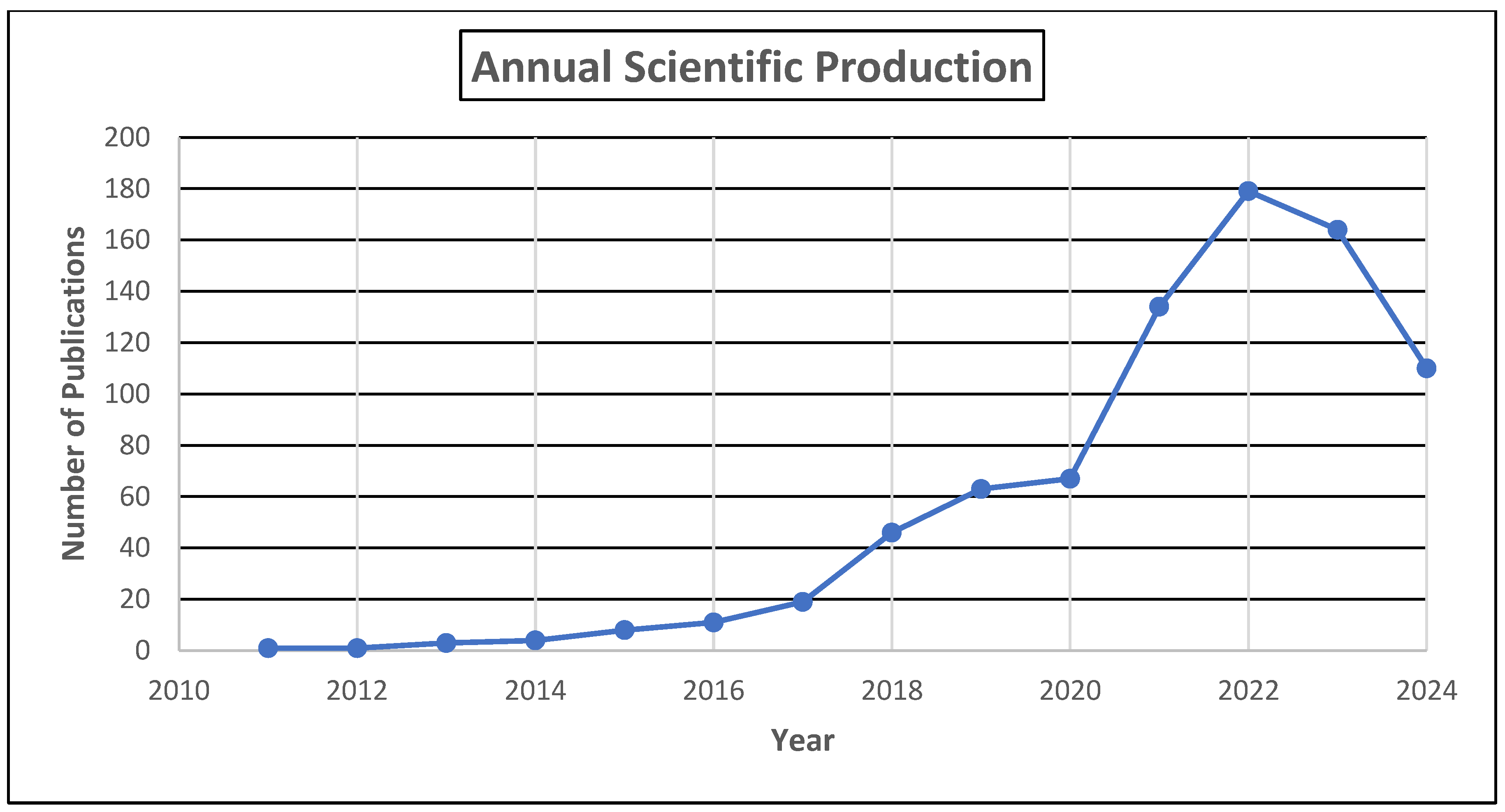


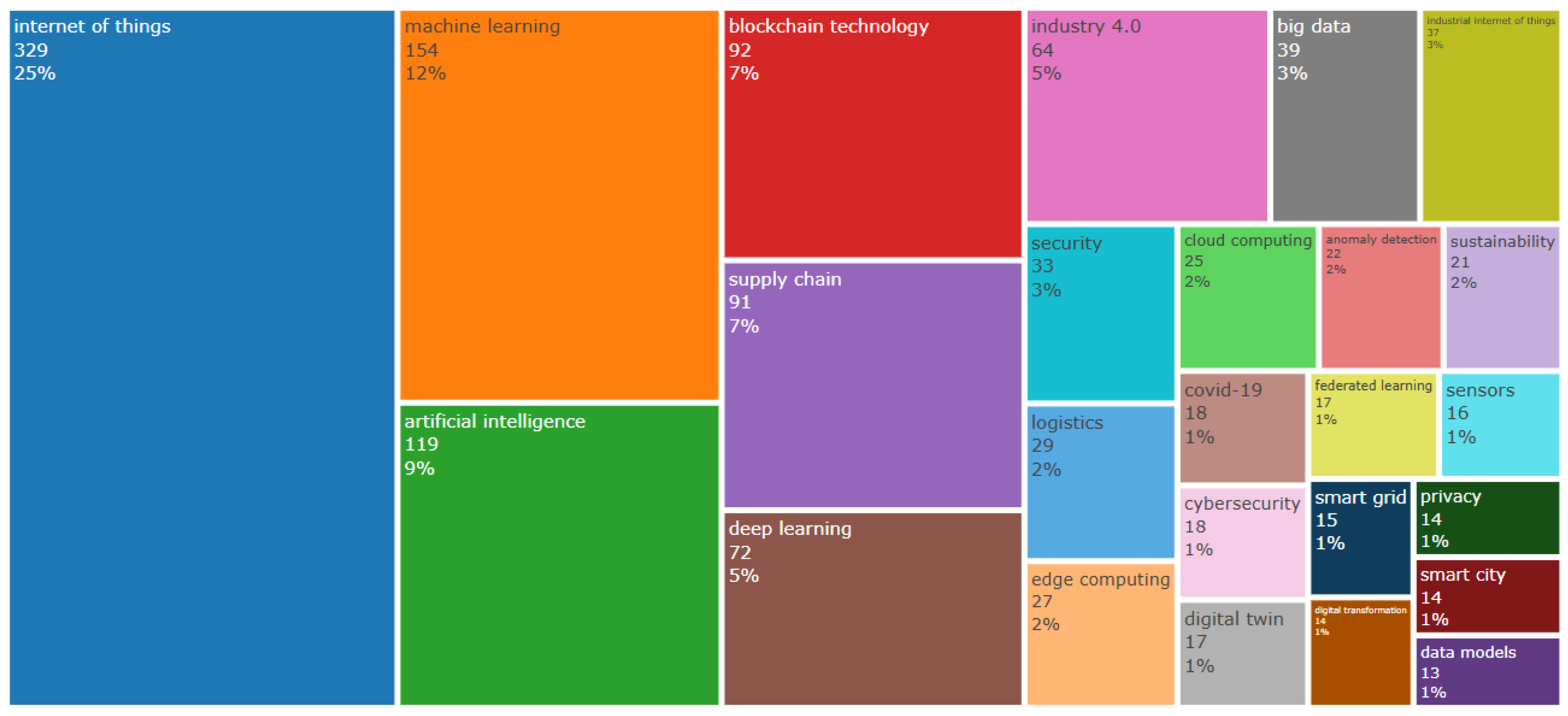

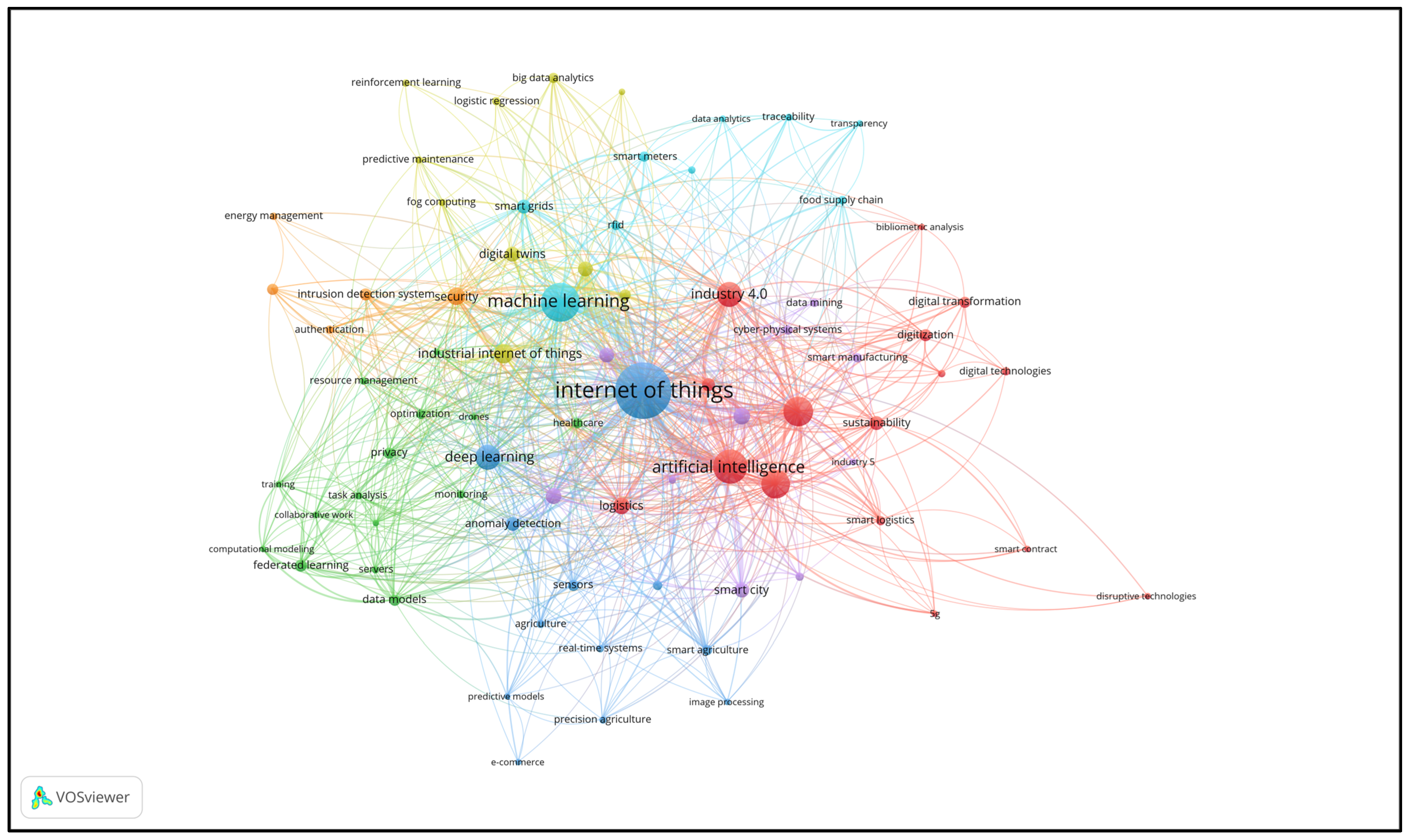
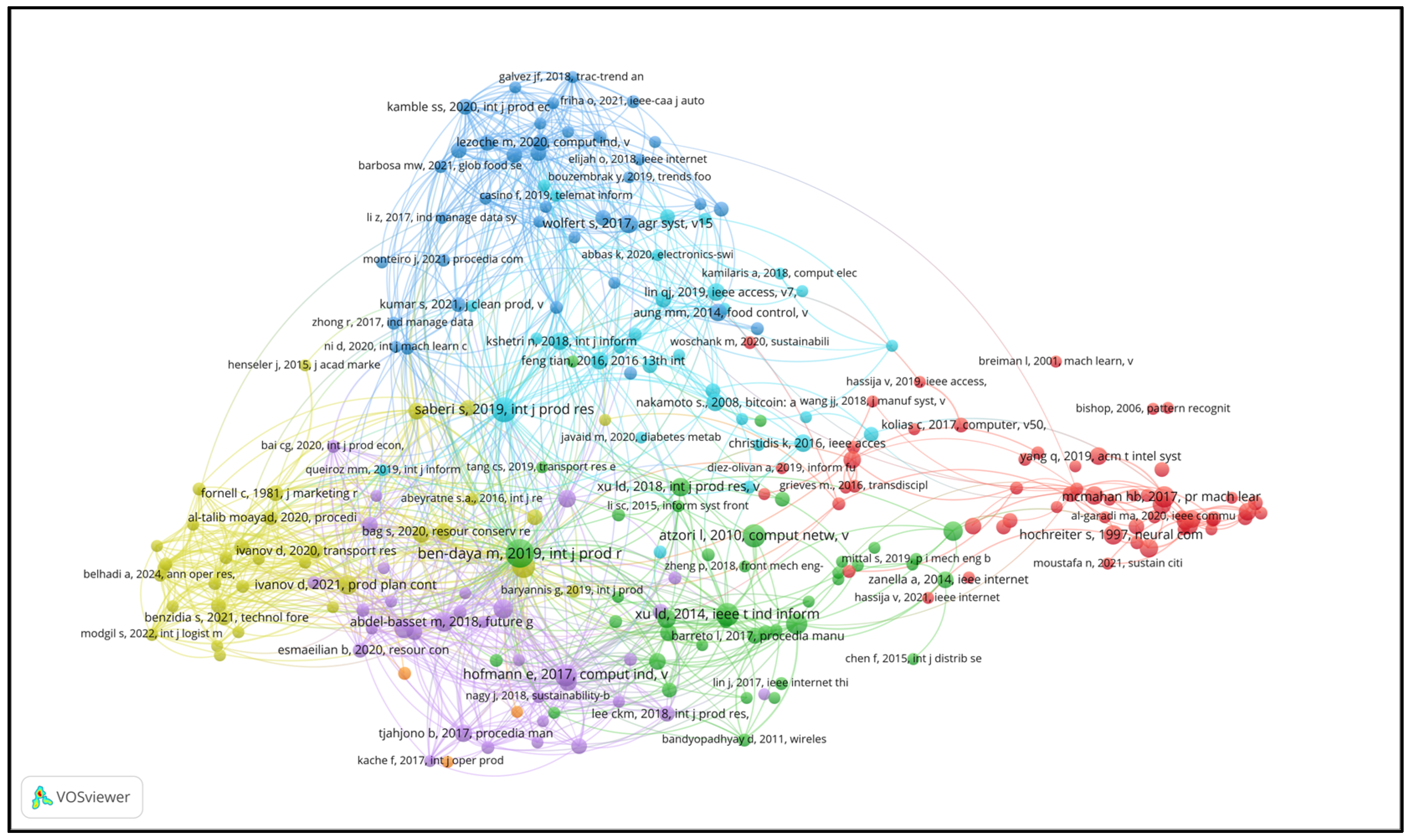
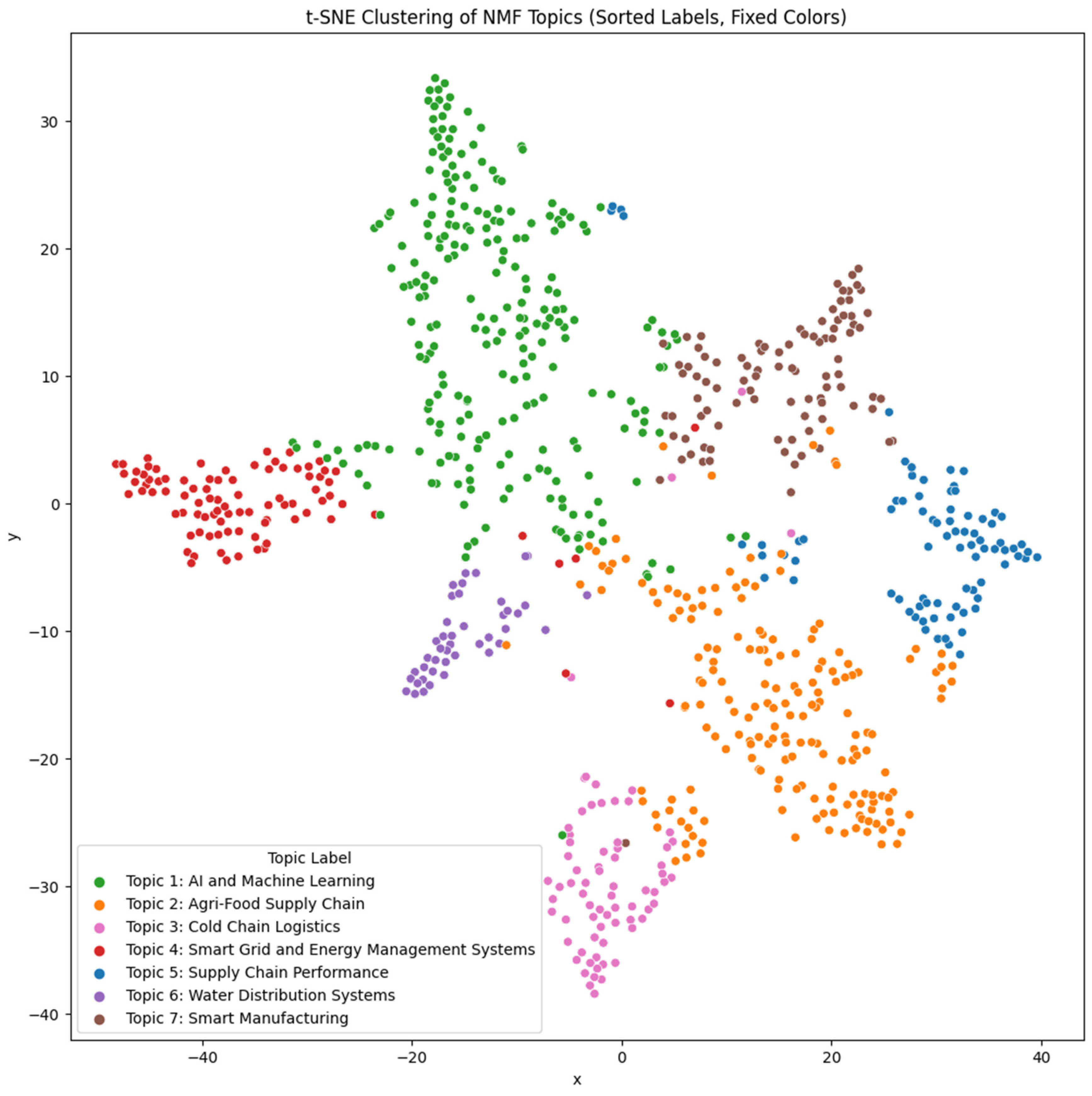


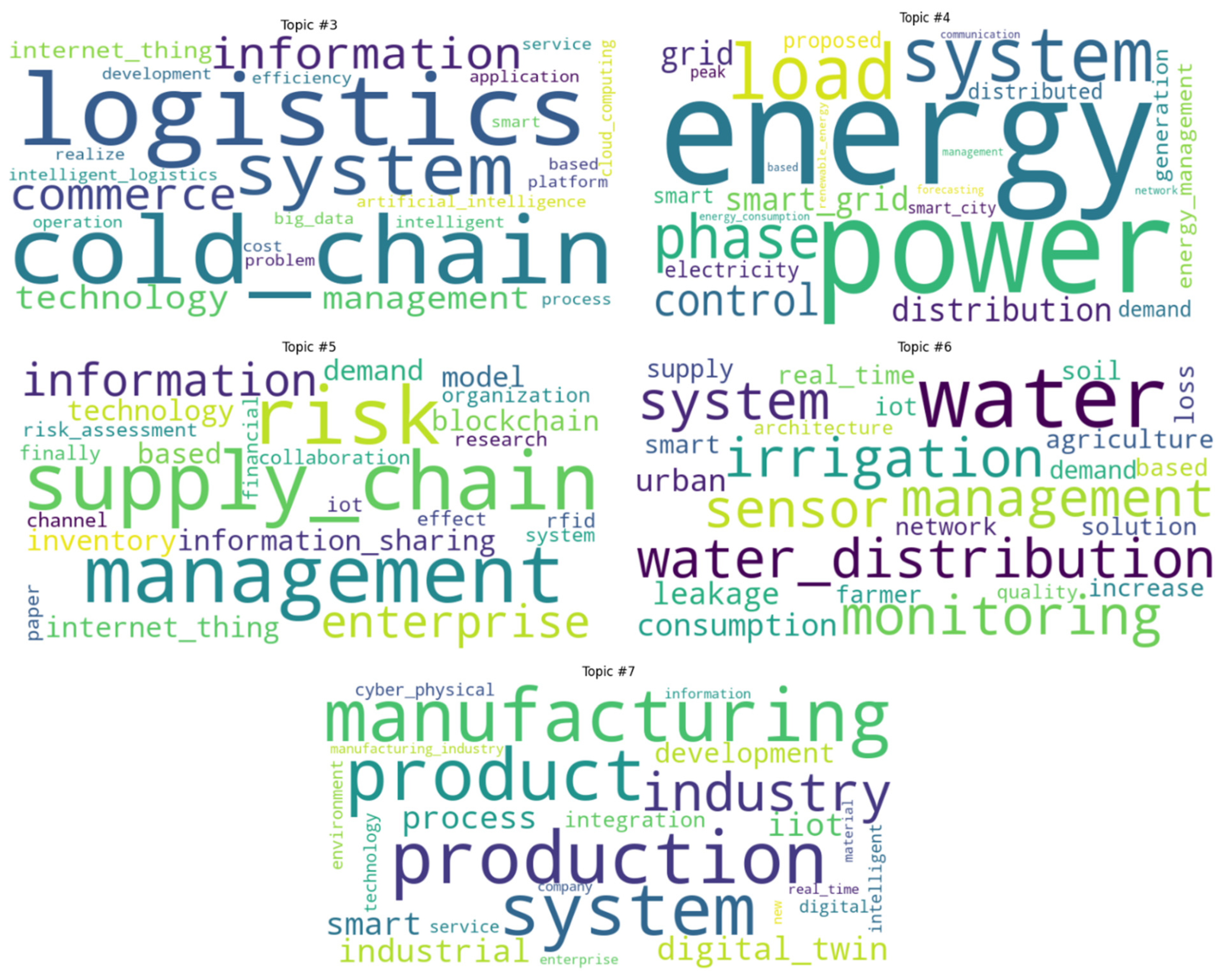


| Theme | Co-Occurrence Network Analysis of Authors’ Keywords | Co-Citation Network Analysis of Cited References | Topic Modeling | |||||
|---|---|---|---|---|---|---|---|---|
| Keyword | O | TLS | Document | Citations | Source | TLS | Keywords | |
| AI and Machine Learning | (McMahan et al., 2017) | 15 | Proceedings of Machine Learning Research | 29 | data | |||
| (Kingma & Ba, 2014) | 11 | Computer Science & Engineering | 24 | machine learning | ||||
| (Lecun et al., 1998) | 11 | Proceedings of the IEEE | 19 | attack | ||||
| (LeCun et al., 2015) | 11 | Intelligent Control & Automation | 23 | security | ||||
| (Qi & Tao, 2018) | 10 | IEEE Access | 49 | network | ||||
| Agri-Food Supply Chain | internet of things | 317 | 666 | (Wolfert et al., 2017) | 11 | Agricultural Systems | 65 | artificial intelligence |
| deep learning | 66 | 144 | (Aung & Chang, 2014) | 10 | Food Control | 53 | food | |
| anomaly detection | 20 | 50 | (Lezoche et al., 2020) | 5 | Computers in Industry | 50 | technology | |
| sensors | 14 | 51 | (Kamath, 2018) | 8 | The Journal of the British Blockchain Association | 65 | big data | |
| smart agriculture | 12 | 40 | (Kamble et al., 2020) | 8 | International Journal of Information Management | 59 | blockchain | |
| Smart Grid and Energy Management Systems | security | 33 | 100 | smart grid | ||||
| intrusion detection system | 16 | 39 | electricity | |||||
| neural network | 13 | 19 | distribution | |||||
| authentication | 8 | 25 | energy | |||||
| energy management | 6 | 7 | control | |||||
| Smart Manufacturing | industrial internet of things | 38 | 87 | (Cavalcante et al., 2019) | 6 | International Conference on Service Systems and Service Management (ICSSSM) | 33 | manufacturing |
| digital twins | 23 | 49 | (Oesterreich & Teuteberg, 2016) | 5 | Computers in Industry | 39 | smart | |
| cloud computing | 22 | 86 | production | |||||
| manufacturing | 13 | 46 | iiot | |||||
| big data analytics | 11 | 29 | industry | |||||
| Digitalization of Supply Chain | artificial intelligence | 118 | 307 | (Saberi et al., 2019) | 20 | International Journal of Production Research | 187 | supply chain |
| blockchain technology | 87 | 252 | (Ivanov et al., 2018) | 18 | International Journal of Production Research | 177 | management | |
| supply chain | 86 | 200 | (Hofmann & Rüsch, 2017) | 16 | Computers in Industry | 125 | risk | |
| industry 4.0 | 64 | 146 | (Ivanov & Dolgui, 2021) | 13 | Production Plan Control | 118 | information | |
| logistics | 28 | 68 | (G. Wang et al., 2016) | 13 | International Journal of Production Economics | 127 | technology | |
Disclaimer/Publisher’s Note: The statements, opinions and data contained in all publications are solely those of the individual author(s) and contributor(s) and not of MDPI and/or the editor(s). MDPI and/or the editor(s) disclaim responsibility for any injury to people or property resulting from any ideas, methods, instructions or products referred to in the content. |
© 2025 by the authors. Licensee MDPI, Basel, Switzerland. This article is an open access article distributed under the terms and conditions of the Creative Commons Attribution (CC BY) license (https://creativecommons.org/licenses/by/4.0/).
Share and Cite
Zaman, J.; Shoomal, A.; Jahanbakht, M.; Ozay, D. Driving Supply Chain Transformation with IoT and AI Integration: A Dual Approach Using Bibliometric Analysis and Topic Modeling. IoT 2025, 6, 21. https://doi.org/10.3390/iot6020021
Zaman J, Shoomal A, Jahanbakht M, Ozay D. Driving Supply Chain Transformation with IoT and AI Integration: A Dual Approach Using Bibliometric Analysis and Topic Modeling. IoT. 2025; 6(2):21. https://doi.org/10.3390/iot6020021
Chicago/Turabian StyleZaman, Jerifa, Atefeh Shoomal, Mohammad Jahanbakht, and Dervis Ozay. 2025. "Driving Supply Chain Transformation with IoT and AI Integration: A Dual Approach Using Bibliometric Analysis and Topic Modeling" IoT 6, no. 2: 21. https://doi.org/10.3390/iot6020021
APA StyleZaman, J., Shoomal, A., Jahanbakht, M., & Ozay, D. (2025). Driving Supply Chain Transformation with IoT and AI Integration: A Dual Approach Using Bibliometric Analysis and Topic Modeling. IoT, 6(2), 21. https://doi.org/10.3390/iot6020021






